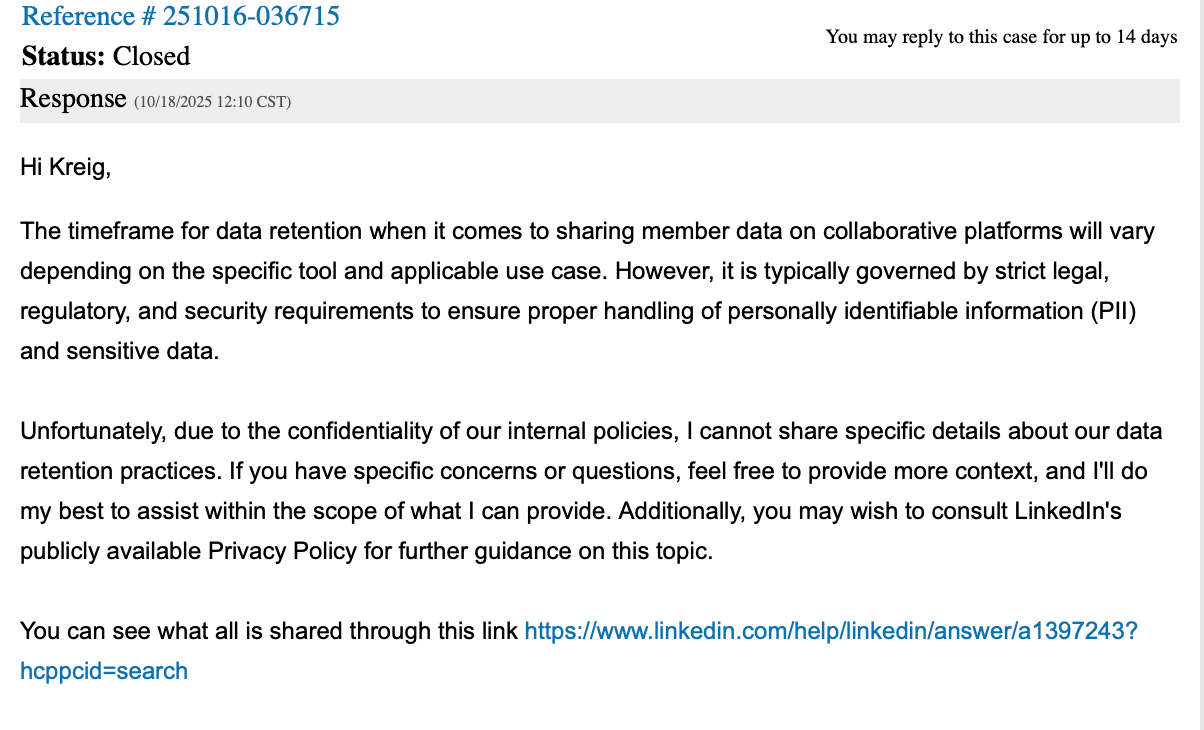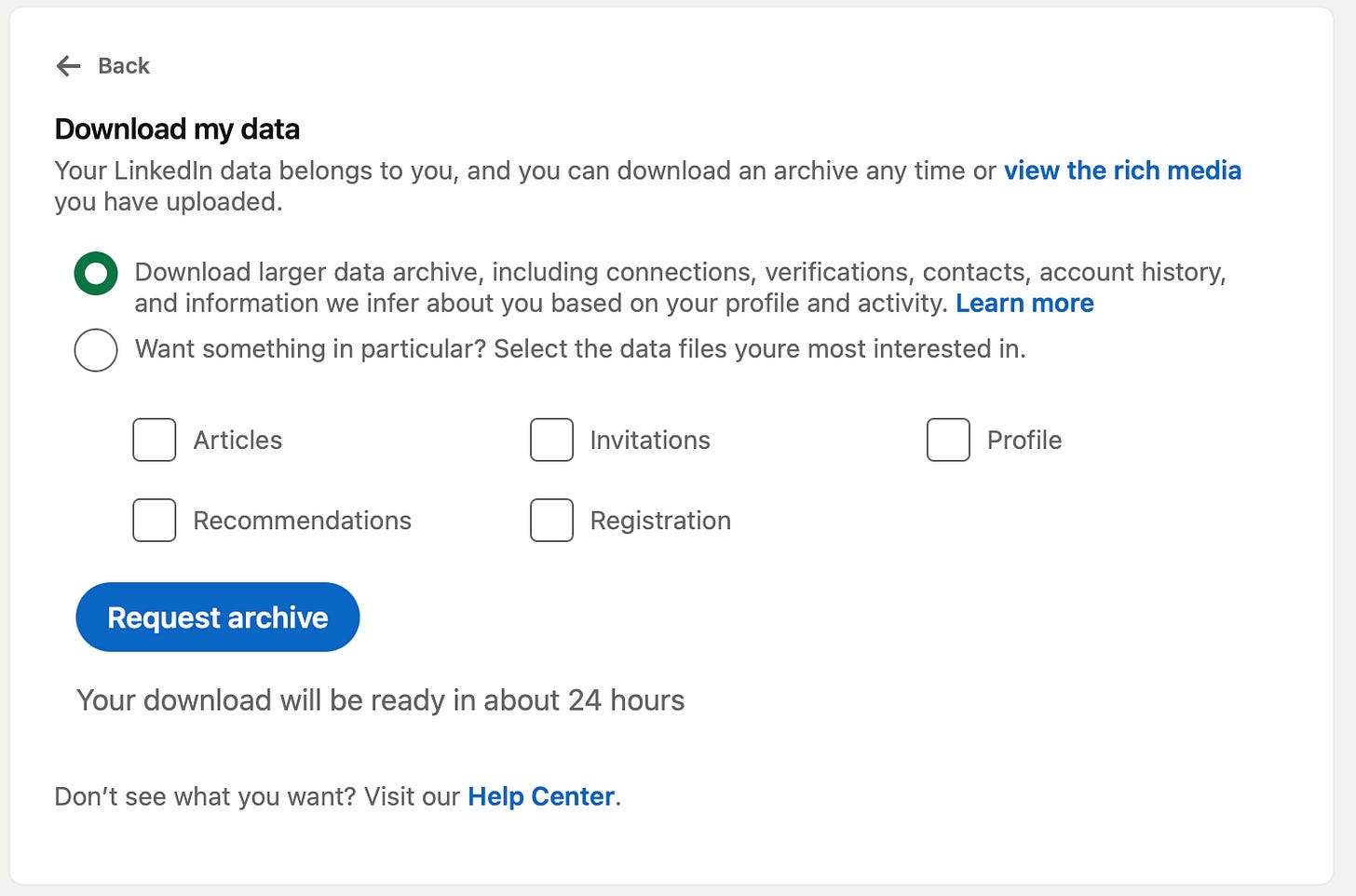Disrupt thyself
Why I removed my LinkedIn profile

“By continuing to use our Services after November 3, 2025, you are agreeing to these updated Terms of Service. If you do not agree to the new terms, you can choose to discontinue using the products and services, and close your LinkedIn account before these terms become effective.”
The recent updates to LinkedIn’s Terms of Service raised concern for many users, myself included. With over 20 years on that platform (Jul 2005 is when I created my profile), by far my oldest social network, the decision to allow Microsoft to aggregate two decades of usage data for advertising purposes is not trivial. The ultimatum, delete your account by Nov 3 or you’re agreeing puts a sharp point to the matter. Additionally, the lack of clarity around what would constitutes violations relating to deep fakes or wrongful impersonations contributes to the uncertainty of these new terms.
My value derived from the platform has shifted over the years and prompts a reevaluation of its role in my professional networking. I’m not alone as many users have remarked how LinkedIn seems more Facebook for business now than professional networking.
Key points from the updated Terms of Service include an expansion in data sharing with Microsoft, as well as the acknowledgment that changes may occur without prior notice due to legal requirements or new product launches.
The mention of addressing deep fakes and wrongful impersonations, essential at some level today, raises questions about their internal decision-making processes and transparency. Which is to say, they aren’t. This was made clear when I tried to find out how far back their data goes that they’re sharing with Microsoft.
The combination of all three. Surely this won’t occur on day one, but as I’ve written before, even as a paid premium subscriber, you’re not the customer. Their target customer, the ones that move the needle, are enterprises. Those big subscriptions for LinkedIn Learning, LinkedIn Sales, and LinkedIn Recruiting. These are the real customers and all of that enriched data is one helluva marshmallow to ignore.
These concerns exist on a slope of possibilities and surely, at least in the beginning, won’t all combine at once - except in accepting the Terms of Service. That ties them all up nicely now, doesn’t it? It’s crucial to consider the implications of these updates and how they may impact user experiences and interactions on the platform. The provided links offer further insights into the evolving landscape of data privacy and platform policies.
These links are shared to illustrate some additional information on concerns these types of data have produced.
Xandr (Microsoft AdTech) refuses to comply with GPDR (German Source)
Unintended Consequences of deplatforming on spread of hateful content
Deep Dive
This is a long post, thanks for sticking it out. I felt I needed to get this done today, Friday October 31, 2025, only a few days before LinkedIn’s new TOS. My greatest hope is that it will surface some consideration by people who care, but do not spend their idle time digging in on subjects like this. I also know those who really care but are stuck with their LinkedIn because of work necessity. I just completed my data-dump from LinkedIn prior to deleting my profile and wanted to share just how far back some of this data can go.
One caveat, me being me I had already gone through a rather substantial pruning of posts and comments in the last year as Ai usages, known and unknown, began to proliferate.
Inferences
LinkedIn builds a set of inferences about you. These can be implied or explicit based upon what information you provide. Keep in mind, as they said in the email to me, they don’t describe their data retention policies either. So, they may keep historical snapshots of your changes through time for nearly all of these records.
These inferences are highly-valuable to advertisers and all of them build some version of these for their marketing purposes. So don’t think that LinkedIn, or Microsoft, are doing anything exceptional here.
Ads Clicked
Of all the data included in the data-dump that will be forked over to Microsoft’s AdTech systems this one is the most obvious, Ads I have clicked on. As you can see, this data doesn’t go too far back, only the last year or so. Still, this is a very strong signal of interest (in Advertising terms) and the algorithms just LOVE this type of data point. Now, unfortunately, they have NO idea whether I intended to click on the ad (almost NEVER) or whether it was the result of a slow scroll, an errant thumb, or some other PEBKAC malfunction. Regardless, in an ad driven model, this one is an obvious one.
Reaction and Shares
These two allow the models to ‘understand’ more about you than can simply be inferred from who you’re connected to. The later being an obvious graph. So what did I find when I went digging?
LinkedIn has kept track of my Reactions (which I was not able to manually remove) since January 31st of 2014. These are highly valuable for inference enrichment. These include Like, Praise, Interest, Entertainment, Empathy, Appreciation, and Maybe. My dataset had 3,516 of these records. As I mentioned in my post A History of Ai large data systems have been data starved which is why we’ve seen such flagrant disregard for intellectual property rights and privacy.
Then there’s the other side of the network graph and a much stronger type of signal - a share. This represents a deeper level of interaction and may/may not be assigned a stronger weighting in determining your persona. One of the key things you want to think about here is - why? Why did you share something? Was it something that you identified deeply with? Something that bothered you? Perhaps something that you were undecided on and were looking for more information on. I know people who will intentionally post divisive content to spark engagement. Have you ever done something similar? Something to take note of here, notice that this goes back nearly two full years farther. Curious… no?
Follow/Unfollow
This one was super interesting as I had completely forgotten about many of these. Ah, but never fear, the platform did not! When you enrich your connection graph with this information and all the other users data, profile information, sentiment, and external sources (remember, they continuously aggregate public and private data to augment these models) you end up with a fairly interesting (creepy) way. Once again notice how this data goes even farther back. I can’t honestly say if I had any follow/unfollows before this time as, like I said, I forgot about many of these.
Leveling Out
I know that de-platforming myself from LinkedIn will result in a terrible attrition. However, if you’d told me in July of 2005 that LinkedIn would save every action, click, comment, message, image, post, follow/unfollow, connect/disconnect for the next 20 years to enrich one of the world’s largest AdTech systems? I wouldn’t have signed-up, would you?








